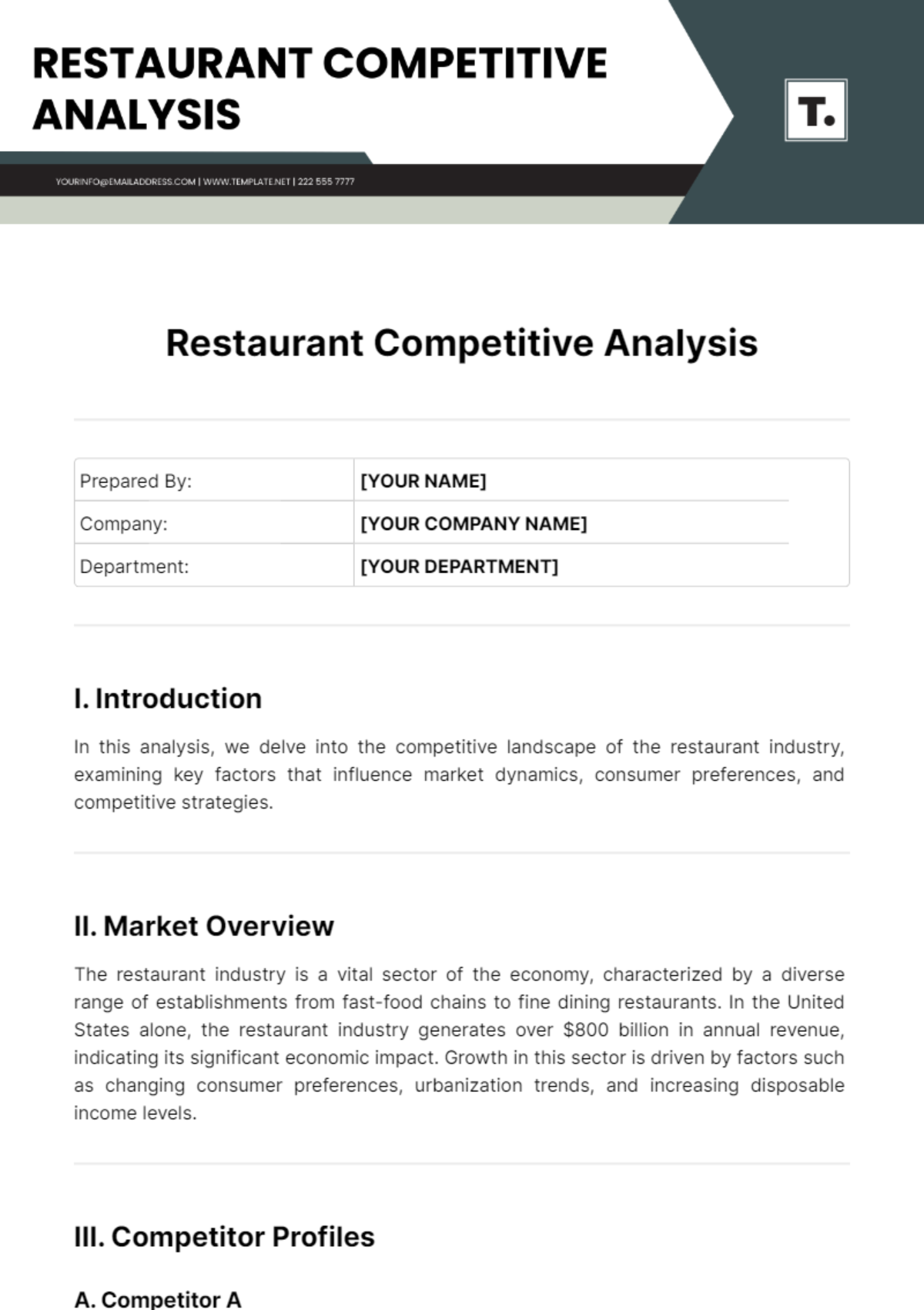Free Restaurant Competitive Analysis

Prepared By: | [YOUR NAME] |
Company: | [YOUR COMPANY NAME] |
Department: | [YOUR DEPARTMENT] |
I. Introduction
In this analysis, we delve into the competitive landscape of the restaurant industry, examining key factors that influence market dynamics, consumer preferences, and competitive strategies.
II. Market Overview
The restaurant industry is a vital sector of the economy, characterized by a diverse range of establishments from fast-food chains to fine dining restaurants. In the United States alone, the restaurant industry generates over $800 billion in annual revenue, indicating its significant economic impact. Growth in this sector is driven by factors such as changing consumer preferences, urbanization trends, and increasing disposable income levels.
III. Competitor Profiles
A. Competitor A
Strengths:
Diverse menu offerings catering to various dietary preferences, including vegan and gluten-free options.
Strong brand recognition and loyal customer base built over decades of operation.
Weaknesses:
Limited online presence and digital marketing efforts, resulting in missed opportunities to engage with younger demographics.
Inconsistent service quality across locations, leading to mixed customer reviews.
Strategies:
Expansion into new markets through franchise partnerships, with a focus on international markets.
Introduction of innovative menu items and limited-time offers to create buzz and attract younger demographics.
B. Competitor B
Strengths:
The streamlined ordering process with a user-friendly mobile app, offers convenience and speed to customers.
Effective loyalty program driving repeat business and fostering a sense of loyalty among customers.
Weaknesses:
Reliance on third-party delivery services for off-premise dining leads to high fees and potential service quality issues.
The lack of differentiation in menu offerings compared to competitors makes it challenging to stand out in a crowded market.
Strategies:
Investment in technology to enhance the customer experience, including digital kiosks for in-store ordering and payment.
Collaboration with local influencers and food bloggers for targeted marketing campaigns aimed at millennials and Gen Z consumers.
IV. Pricing Analysis
Pricing strategies vary among competitors, with some focusing on value propositions to attract price-conscious consumers, while others emphasize premium offerings and dining experiences. Competitor A positions itself as a mid-range option, offering quality food at affordable prices, while Competitor B adopts a slightly higher pricing strategy, targeting customers willing to pay a premium for convenience and quality.
V. Marketing Approaches
A. Digital Marketing
Both Competitor A and Competitor B utilize social media platforms such as Instagram, Facebook, and Twitter for brand promotion and engagement. They regularly post mouth-watering food images, behind-the-scenes content, and promotional offers to attract followers and drive traffic to their establishments.
Email marketing campaigns are employed by Competitor A to target existing customers with personalized offers and discounts, while Competitor B focuses on building its subscriber list through incentives like free appetizers or desserts for signing up.
B. Traditional Marketing
Competitor A sponsors local events and community outreach initiatives to increase brand visibility and foster goodwill within the community.
Competitor B invests in print advertisements in relevant publications, such as local newspapers and lifestyle magazines, to reach a broader audience and drive foot traffic to its locations.
VI. Customer Feedback Analysis
Both Competitor A and Competitor B actively monitor customer reviews and feedback across various platforms, including review websites like Yelp, Google Reviews, and TripAdvisor, as well as social media channels.
Common themes in customer feedback include praise for friendly staff, delicious food, and cozy ambiance, as well as criticism regarding long wait times, slow service, and inconsistent food quality.
Competitor A responds to negative reviews promptly, offering apologies and solutions to rectify the situation, while Competitor B focuses on encouraging positive reviews through incentives like discounts on future visits.
VII. Opportunities and Threats
A. Opportunities
Expansion into untapped markets with high demand for restaurant services, such as suburban areas experiencing population growth and urban neighborhoods undergoing revitalization efforts.
Introduction of healthier menu options, including plant-based alternatives and low-calorie dishes, to cater to the growing health-conscious consumer segment seeking nutritious yet delicious dining options.
B. Threats
Intensifying competition from new market entrants, including fast-casual chains and delivery-only ghost kitchens, challenging established players to differentiate themselves and maintain market share.
Economic downturns and external factors such as natural disasters or public health crises (e.g., the COVID-19 pandemic) impact consumer spending on dining out and discretionary expenses, leading to decreased foot traffic and revenue for restaurants.
VIII. Conclusion
In conclusion, a comprehensive understanding of the competitive landscape within the restaurant industry is crucial for [Your Company Name] to capitalize on emerging opportunities and navigate potential challenges effectively. By leveraging insights from this analysis, [Your Company Name] can refine its strategies and offerings to maintain a competitive edge in the market.
- 100% Customizable, free editor
- Access 1 Million+ Templates, photo’s & graphics
- Download or share as a template
- Click and replace photos, graphics, text, backgrounds
- Resize, crop, AI write & more
- Access advanced editor
Discover the ultimate tool for gastronomic entrepreneurs: the Restaurant Competitive Analysis Template by Template.net. Crafted with precision, it's not just a document; it's your roadmap to culinary success. Fully editable and customizable, it empowers you to analyze, strategize, and thrive in the competitive culinary landscape. Plus, it's seamlessly editable in our AI editor, ensuring efficiency and excellence.





























